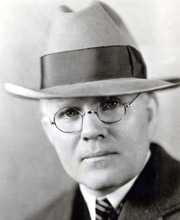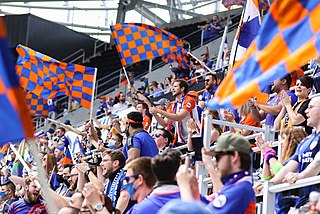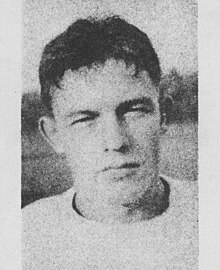Below is a list of professional football Championship Games in the United States, involving:

Joseph Francis Carr was an American sports executive in football, baseball, and basketball. He is best known as the president of the National Football League from 1921 until 1939. He was also one of the founders and president of the American Basketball League (ABL) from 1925 to 1927. He was also the promotional director for Minor League Baseball's governing body from 1933 to 1939, leading an expansion of the minor leagues from 12 to 40 leagues operating in 279 cities with 4,200 players and attendance totaling 15,500,000.
The 1920 APFA season was the inaugural season of the American Professional Football Association, renamed the National Football League in 1922. An agreement to form a league was made by four independent teams from Ohio on August 20, 1920, at Ralph Hay's office in Canton, Ohio, with plans to invite owners of more teams for a second meeting on September 17, 1920. The "American Professional Football Conference" (APFC) was made up of Hay's Canton Bulldogs, Akron Pros, the Cleveland Tigers and the Dayton Triangles, who decided on a six-game schedule to play each other at home-and-away, an agreement to respect each other's player contracts, and to take a stand against signing college students whose class had not yet graduated.

Cincinnati is the home of three major league teams, three minor league teams, five college institutions with sports teams, and numerous top level amateur teams.
The Cincinnati Bengals were a short-lived professional football team that played in Cincinnati, Ohio. It is unrelated to the current Cincinnati Bengals. Originated by Hal Pennington, the team was formed as a member of the second American Football League in the 1937 season. The Bengals finished with a 2–3–2 record in their first year, but the league folded after the season, and Pennington returned to his former team, the Cincinnati Models, which would change its name to the Cincinnati Blades for an ill-fated 1938 campaign. Pennington was replaced by new player-coach Dana King, who would guide the Bengals for the remainder of the team's existence.
The American Football League, also known retrospectively as the AFL III to distinguish it from earlier organizations of that name, was a professional American football league that operated from 1940 to 1941. It was created when three teams, the original Cincinnati Bengals, the Columbus Bullies, and the Milwaukee Chiefs, were lured away from the minor-league American Professional Football Association and joined three new franchises in Boston, Buffalo, and New York City in a new league. It competed against the National Football League (NFL), the oldest existing professional football league, which had been established in 1920 and reorganized in 1922.
The American Football League (AFL) was a professional American football league that operated in 1936 and 1937. The AFL operated in direct competition with the more established National Football League (NFL) throughout its existence. While the American media generally ignored its operation, this second AFL was the first "home" of the Cleveland Rams, which joined the National Football League after one year in the AFL.

The Columbus Bullies were a professional football team founded by Dean Carter in Columbus, Ohio, in 1938. The Bullies started out as a member of the American Professional Football Association (APFA) in 1939. Later, in 1940, the Bullies joined the Cincinnati Bengals and Milwaukee Chiefs in leaving the APFA and becoming charter members of a new American Football League. Playing in Red Bird Stadium, the Bullies won both AFL Championships prior to ceasing operations when the AFL disbanded due to World War II. The Bullies defeated the Milwaukee Chiefs in 1940, and the New York Americans in 1941 in the only two AFL Championships.
The Pacific Coast Professional Football League (PCPFL), also known as the Pacific Coast Football League (PCFL) and Pacific Coast League (PCL) was a professional American football minor league based in California. It operated from 1940 through 1948. One of the few minor American professional sports leagues that competed in the years of World War II, the PCPFL was regarded as a minor league of the highest level, particularly from 1940 to 1945, at a time in which the National Football League (NFL) did not extend further west than Chicago and Green Bay. It was also the first professional football league to have a team based in Hawaii.

The Los Angeles Bulldogs were a professional American football team that competed from 1936 to 1948. Formed with the intention of joining the National Football League in 1937, the Bulldogs were the first team on the major league level to play its home games on the American West Coast. They were considered "the best football team in existence outside the NFL".
The 1940 AFL season was the first season of the third American Football League. The league was formed when the New York Yankees, Boston Bears, and Buffalo Indians were joined by the Cincinnati Bengals, Columbus Bullies, and Milwaukee Chiefs of the minor American Professional Football Association. After the announcement of the formation of the AFL, applications for membership by former APFA members St. Louis Gunners and Kenosha Cardinals were rejected by the upstart league, which started with six members.
The Buffalo Indians were a professional American football team that competed in the third American Football League in 1940 and in 1941. The team played its home games in Civic Stadium in Buffalo, New York. Owned by the Buffalo American Legion, the Indians were managed by Earl "Red" Seick, who was also player-coach for the team for the first five games in 1940. While most of the AFL membership focused on raiding the rosters of the local members of the National Football League teams, the Indians concentrated on signing local talent, castoffs from the NFL, and men who played in the defunct second American Football League.
The Ohio League was an informal and loose association of American football clubs active between 1902 and 1919 that competed for the Ohio Independent Championship (OIC). As the name implied, its teams were mostly based in Ohio. It is the direct predecessor to the modern National Football League (NFL).
The Louisville Tanks were a minor league professional American football team that existed from 1935 to 1940. The team formed in the wake of the dissolution of the Louisville Bourbons of the short-lived American Football League of 1934. Organized and owned by American Standard, Inc., the team was coached by AS plant manager H.M. "Harry" Reed; its name and colors come from one of the products sold by American Standard. The Tanks played their home games at Parkway Field in Louisville, Kentucky, USA.
The New York Yankees of the second American Football League was the second professional American football team competing under that name. It is unrelated to the Yankees of the first AFL, the Yankees of the third AFL, the Yankees of the American Association and the (later) Yankees of the All-America Football Conference. The Yankees played their home games in Yankee Stadium and Triborough Stadium in New York, New York. Jack McBride was the team’s head coach throughout its existence; Yankees' president James Bush served as president of the second American Football League in 1936.
This timeline of the National Football League (NFL) tracks the history of each of the league's 32 current franchises from the early days of the league, through its merger with the American Football League (AFL). The history of franchises that began as independent teams, or as members of the Ohio League, New York Pro Football League, and other defunct leagues are shown as well.

Ohio is home to many professional and college sports teams. The metropolitan areas of Cleveland, Cincinnati, and Columbus are home to major league professional sports teams in baseball, basketball, football, hockey, and soccer.
The Midwest Football League (MFL) was a low-level professional American football minor league that played games from 1962 to 1978. The league was based mainly in Michigan, until the collapse of the Continental Football League in 1969, when it became more of a regional league.
Coleman G. Willging was an American football end who played one season in the National Football League (NFL) for the Cincinnati Reds. He also played in the Midwest Football League and AFL III as a member of the Cincinnati Models and Bengals. He was assistant coach of the Models from 1936 to 1937.





